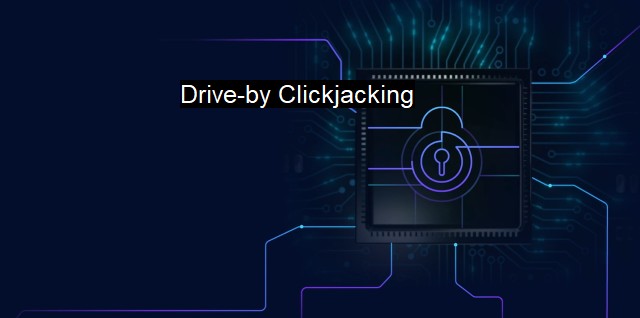What is Drive-by Clickjacking?
Explanation and Risks of Drive-By Clickjacking: An Emerging Cybersecurity Threat to Online Users' Identity and Financial Data
Drive-by clickjacking is a method employed by cybercriminals for deceiving internet users into unknowingly clicking on hidden malicious web links or elements which may lead to unauthorized activities or install malware on the victim's device. This technique is hidden under a layer of seemingly innocent content, leaving the victim oblivious to its harmful intent.The term "clickjacking" derives from a combination of "click" and "hijacking," explaining how this nefarious tactic operates. with clickjacking, a cyberattacker takes the user's intended click—perhaps meant for a download button or a login form—and redirects it to perform an unintended action unknown to the user. This might include anything from downloading harmful malware to posting unwanted social media content on their behalf.
Contrary to pop-up ads or website banners that attempt to trick users through persuasion, a drive-by clickjacking attack remains entirely transparent to the user. In this scenario, a conspicuous button or web interface element, which the user willingly interacts with, conceals the illicit activity. Attackers disguise their harmful intent behind seemingly benign web objects such as videos, download buttons, or sign-in modules, which when manipulated can silently authorize unintended actions.
For instance, suppose a user attempts to click a button for downloading a file from a website. the attacker superimposes a transparent layer that, when clicked, triggers a different action without the user's knowledge, such as liking a Facebook page, following a Twitter account, or even downloading a different file that might be laden with malware. This technique is drive-by clickjacking, a type of ‘UI redress attack’ exploiting the trust of internet users.
The advent of drive-by clickjacking makes the internet a precarious playground. Personal computers and mobile devices all face the potential to get struck by this attack. No user action beyond the normal web browsing is needed to activate the download of a malware onto the targeted device. It's a particularly effective method since it requires no social engineering tricks to convince the victim to download an unknown file.
In the cybersecurity context, this invasive attack is highly challenging to prevent due to its covert nature. But users can defensively act against drive-by clickjacking by adopting safe browsing habits, like avoiding unfamiliar or untrusted websites, scrutinizing suspiciously placed website elements, and regularly updating web browser versions to include the newest security patches and features. it's advised to use plugins like NoScript or script-blocking functionalities that most updated browsers support to prevent suspicious scripts from running on websites.
Antivirus solutions play a significant role in detecting and neutralizing drive-by download malicious activities. Paired with powerful firewalls and real-time scanning modules, today's sophisticated antivirus products can detect, isolate, and eliminate malware before it's activated. By continually updating their virus libraries and deploying cutting-edge AI technology, modern antivirus software can discern an ever-evolving array of malware—including the one that could be a payload of clickjacking.
Exploiting a user through drive-by clickjacking involves severe privacy and law violations. Breaching someone's privacy rights can carry substantial legal implications, making such activities not only unethical but also illegal.
Drive-by clickjacking represents a severe cybersecurity threat that uses deceit to manipulate internet users, employing transparency to execute unintended actions. Despite the cunning nature of these attacks, timely antivirus updates, safe web practices, and script-blocking tools can significantly enhance online security and protect users from unwittingly becoming cyberattack victims.

Drive-by Clickjacking FAQs
What is drive-by clickjacking?
Drive-by clickjacking is a type of online attack where malicious actors hijack a user's clicks on a webpage to perform actions that the user didn't intend to perform, such as clicking on a button that initiates a download of malware or transferring funds to a hacker's account.How does drive-by clickjacking work?
Drive-by clickjacking works by overlaying invisible web elements on top of legitimate clickable elements on a webpage. When a user clicks on the visible element, they unknowingly trigger the action associated with the invisible element, such as downloading malware or giving away personal information to a hacker.How can I protect myself from drive-by clickjacking?
To protect yourself from drive-by clickjacking, you should use an up-to-date anti-virus and anti-malware software that can detect and block malicious software downloads. Additionally, you should avoid clicking on links or buttons on websites that you don't trust, and use a browser with strong security features and extensions that block clickjacking.What are the consequences of falling victim to drive-by clickjacking?
The consequences of falling victim to drive-by clickjacking can be severe, including theft of personal and financial information, loss of access to important data, financial damage, and damage to your computer or device. It is important to take steps to prevent clickjacking attacks, and to be vigilant in detecting and responding to potential threats.| | A | | | B | | | C | | | D | | | E | | | F | | | G | | | H | | | I | | | J | | | K | | | L | | | M | |
| | N | | | O | | | P | | | Q | | | R | | | S | | | T | | | U | | | V | | | W | | | X | | | Y | | | Z | |
| | 1 | | | 2 | | | 3 | | | 4 | | | 7 | | | 8 | | |||||||